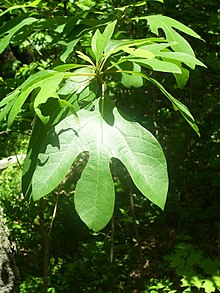Sassafras
| Sassafras | |
|---|---|
 |
|
|
Sassafras albidum, Wanaque, New Jersey |
|
| Scientific classification | |
| Kingdom: | Plantae |
| (unranked): | Angiosperms |
| (unranked): | Magnoliids |
| Order: | Laurales |
| Family: | Lauraceae |
| Genus: |
Sassafras J.Presl |
| Species | |
| Synonyms | |
|
Pseudosassafras Lecomte |
|
S. albidum
†S. hesperia
S. randaiense
S. tzumu
†S. yabei
Pseudosassafras Lecomte
Sassafras is a genus of three extant and one extinct species of deciduous trees in the family Lauraceae, native to eastern North America and eastern Asia. The genus is distinguished by its aromatic properties, which have made the tree useful to humans.
The name "sassafras", applied by the botanist Nicolas Monardes in 1569, comes from the French sassafras. Some sources claim it originates from the Latin saxifraga or saxifragus: "stone-breaking;" saxum "rock" + frangere "to break"). Early European colonists reported that the plant was called winauk by Native Americans in Delaware and Virginia and pauane by the Timucua. Native Americans distinguished between white sassafras and red sassafras, which terms referred to the same plant but to different parts of the plant with distinct colors and uses. Sassafras was known as fennel wood (German Fenchelholz) due to its distinctive aroma.
Sassafras trees grow from 9–35 m (30–115 ft) tall with many slender sympodial branches, and smooth, orange-brown bark or yellow bark. All parts of the plants are fragrant. The species are unusual in having three distinct leaf patterns on the same plant: unlobed oval, bilobed (mitten-shaped), and trilobed (three-pronged); the leaves are hardly ever five-lobed. Three-lobed leaves are more common in sassafras tzumu and sassafras randaiense than in their North American counterparts, although three-lobed leaves do sometimes occur on sassafras albidum. The young leaves and twigs are quite mucilaginous, and produce a citrus-like scent when crushed. The tiny, yellow flowers are five-petaled; sassafras albidum and sassafras hesperia are dioecious, with male and female flowers on separate trees, while sassafras tzumu and sassafras randaiense have male and female flowers occurring on the same trees. The fruit is a drupe, blue-black when ripe.
...
Wikipedia
